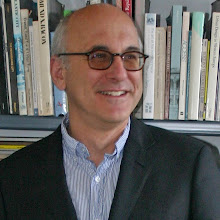I am the president in 2009 of the American Institute of Architects Los Angeles Chapter (LA/AIA). AIA/LA has been increasingly involved in the Los Angeles signage wars. You might wonder why, when the economy is collapsing and architects are loosing their jobs, this particular issue consumes so much time and energy. The simple answer is that AIA/LA started down this road before the present economic circumstance.
Last spring, in an e-mail to AIA/LA’s Political Outreach Committee, one of our members challenged the committee to get engaged in a growing public controversy. Communities were upset at the proliferation of extralegal signage. Billboards and wall wraps with no permits or approvals were sprouting throughout Los Angeles. At the same time sign control advocates were most upset at the introduction of digital billboards looming over residential neighborhoods.
Almost 900 of these winking bright boards are anticipated, the result of a legal row between the City and outdoor advertisers. The latter claimed their rights had been abridged. The City had granted too many sign exceptions. Rather than continue to fight and maybe lose, the City settled and agreed to a set number of screens. A colleague goaded us. If AIA/LA could not take a stand on bright lights shining in people’s bedrooms and sign chaos, what did AIA/LA stand for?
In response to this challenge, the Political Outreach Committee developed what we thought was a nuanced response. AIA/LA suggested an interim control ordinance to give community groups, City staff, and decision-makers a breather. Allow time for enforceable signage regulations to be crafted, debated, and implemented. Subsequently, this position was adopted by the AIA/LA Board and became a part of our legislative agenda presented to City Council members and the Mayor’s office.
I never imagined that this position would resonate. I assumed Los Angeles leaders would interpret this as a message to initiate the drawn out process of revising the sign code. Instead, interim control was embraced. The Planning Commission adopted the idea last November. In December an interim control ordinance was approved by City Council. In January and February the Planning Department released drafts of revised signage regulations. During this time AIA/LA held two public forums exploring first, the place of signs in the urban landscape and second, the design impact of draft regulations.
Because of our support for the interim control ordinance and creation of public sign forums, AIA/LA is perceived as constructively engaged; architect’s opinions matter. Thus I began to get phone calls. Some encouraged AIA/LA to draw a line in the sand and stand with those who want a complete ban on new advertising signs. Others assume that AIA/LA has already taken such a stance.
A few architects called and said stick it to the signifiers. One architect conveyed calls from developers fearful of loosing sign rights, thanks to AIA/LA. One of my clients button holed me and suggested I was destroying the building economy. He then stated that he was only in part joking.
The LA signage debate pits sign abolitionists versus sign advocates and represents a design conundrum. Architects know that signs can contribute to urban vibrancy, whether on the sidewalks of Ginza or the Sunset Strip. Increasingly signs represent an integral and necessary contribution to a design’s bottom line. In this entertainment world capital, signs also promote a unique local industry that invents dreams and images for global consumption. Los Angeles signs, deployed on the exterior walls of movie studios or piercing the night sky, represent the work of our city.
Conversely, it is not unnoticed that Los Angeles is often times ugly. Unmitigated and immersive signage can and does contribute to environmental crassness and blight. Clearly, the opportunities of one point of view represent the constraints of the other. Given this range of opinions, where should AIA/LA stand?
A balance needs to be struck. Surely there are places in Los Angeles where exuberant signage is expected and appropriate. Just as obviously there are locales, such as residential neighborhoods, where most signs, particularly digital signs, are inappropriate. And then there are the places in-between, such as the plethora of commercial and emerging mixed-use boulevards. There is not a uniform design solution possible for these transects but I sense that the general direction that the Planning Department has indicated in their draft signage proposal makes common sense for these streets as well as the city as a whole.
Planning has outlined reductions in the overall allowance for signs compared to what now exists. They have also sought to create consistent definitions of signage that allow for easier enforcement. There are also provisions for signage districts within regional centers that allow means to realize exceptions to the new constraints. The devil of course is in the details of the sign types. These details need to be designed and vigorously debated if any type of balance is to be realized.
Los Angeles architects should have a public opinion on the details because if we don’t our silence is interpreted, at best, as an absence of professional ideas for signage stewardship within our backyard of expertise. At worst, silence suggests to many a lack of professional citizenship or perhaps undue professional acquiescence to client desires.
Why signs? Signage resonates. It forms spaces and places. Signage is symbolic of an urban design and architecture frontier; the qualities of the city’s future are at stake. People are interested in architect’s opinions. Not having a public opinion regarding signage now diminishes the profession’s credibility on too many other issues and thus unnecessarily diminishes the role of architects in shaping our city’s present and future form.
A version of this post will appear in the March/April issue of Form Magazine - Pioneering Design.
AIA|LA UDC Presents...Building Bike-Culture in Los Angeles :: Wednesday,
June 19 (6:30 - 8:30pm)
-
*AIA|LA Urban Design Committee Presents...*
*Building Bike-Culture in Los Angeles*
Wednesday, June 19 (6:30pm - 8:30pm)
AIA Los Angeles
3780 Wilshire Blvd., ...
12 years ago
